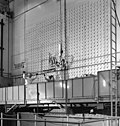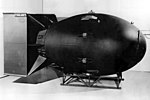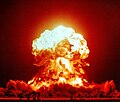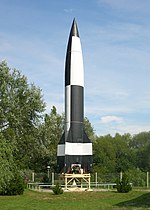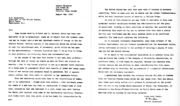A graphite bomb is intended to be a non-lethal weapon used to disable an electrical grid. The bomb works by spreading a dense cloud of extremely fine,...
5 KB (593 words) - 18:23, 2 May 2024
source monitoring tool Nuclear graphite, synthetic graphite used as a neutron moderator in nuclear reactors Graphite bomb, a weapon for disabling electrical...
740 bytes (123 words) - 23:51, 14 February 2023
RBMK (redirect from Light water graphite-moderated reactor)
moshchnosti kanalnyy, "high-power channel-type reactor") is a class of graphite-moderated nuclear power reactor designed and built by the Soviet Union...
96 KB (10,930 words) - 23:26, 27 June 2024
Manhattan Project (redirect from United States atomic bomb project)
Laboratory in the University of Chicago, the project designed the X-10 Graphite Reactor and the production reactors at the Hanford Site, in which uranium...
177 KB (21,563 words) - 01:40, 18 June 2024
The X-10 Graphite Reactor is a decommissioned nuclear reactor at Oak Ridge National Laboratory in Oak Ridge, Tennessee. Formerly known as the Clinton Pile...
49 KB (5,853 words) - 19:12, 23 May 2024
Little Boy (redirect from Hiroshima bomb)
Little Boy was the name of the type of atomic bomb used in the bombing of the Japanese city of Hiroshima on 6 August 1945 during World War II, making it...
58 KB (7,375 words) - 13:31, 30 June 2024
Trinity (nuclear test) (redirect from First atomic bomb)
test was of an implosion-design plutonium bomb, nicknamed the "gadget", of the same design as the Fat Man bomb later detonated over Nagasaki, Japan, on...
109 KB (12,247 words) - 01:40, 23 June 2024
Fat Man (redirect from Nagasaki nuclear bomb)
Major Charles Sweeney. The name Fat Man refers to the early design of the bomb because it had a wide, round shape. Fat Man was an implosion-type nuclear...
47 KB (5,739 words) - 20:16, 26 May 2024
Man" was the code name for a proposed plutonium-fueled gun-type nuclear bomb that the United States was developing during the Manhattan Project. Its development...
17 KB (2,163 words) - 10:37, 29 May 2024
Chicago Pile-1 (category Graphite moderated reactors)
order-of-magnitude uncertainties about the size of a hypothetical bomb. The successful use of graphite as a moderator paved the way for progress in the Allied effort...
68 KB (8,256 words) - 22:59, 20 March 2024
in 1999, including the controversial use of cluster bombs, depleted uranium, and graphite bombs, some of which are claimed to be in violation of international...
4 KB (350 words) - 21:40, 27 March 2024
aerial vehicle LAH (Light Armed Helicopter) exploratory development Graphite bomb Radar for land systems KF-21 Active Electronically Scanned Array (AESA)...
30 KB (2,360 words) - 15:32, 11 June 2024
isotope separation in making a bomb. Instead, Plutonium-239 could be used, which could be produced in a uranium-graphite pile through the absorption of...
69 KB (7,541 words) - 18:43, 16 June 2024
J. Robert Oppenheimer (redirect from Father of the atomic bomb)
Laboratory during World War II. He is often called the "father of the atomic bomb" for his role in overseeing the development of the first nuclear weapons...
169 KB (18,832 words) - 23:09, 29 June 2024
Neutron moderator (section Non-graphite moderators)
most commonly used moderator (roughly 75% of the world's reactors). Solid graphite (20% of reactors) and heavy water (5% of reactors) are the main alternatives...
30 KB (3,767 words) - 11:56, 19 June 2024
Nuclear fission (section Fission bombs)
consisted of a uranium-graphite lattice, consisting of 288 cans, each containing 60 pounds of uranium oxide, surrounded by graphite bricks. Fermi's goal...
73 KB (9,627 words) - 20:21, 30 June 2024
German nuclear program during World War II (redirect from Hitler and the atomic bomb)
Norwegian heavy water production and destroyed stocks of heavy water by 1943. Graphite (carbon) as an alternative was not considered, because the neutron absorption...
73 KB (9,483 words) - 23:25, 16 April 2024
Project Y (section Bomb design concepts)
during World War II. Its mission was to design and build the first atomic bombs. Robert Oppenheimer was its first director, serving from 1943 to December...
129 KB (16,870 words) - 07:21, 27 May 2024
History of nuclear weapons (redirect from Atomic bomb project)
identification and mitigation of a key graphite impurity (boron) through a joint collaboration with graphite suppliers. The beginning of the American...
106 KB (13,586 words) - 15:34, 25 May 2024
Operation Outward (category World War II strategic bombing of Germany)
flying bombs and for the Normandy landings. The last balloons were launched on 4 September 1944. Fu-Go balloon bomb Fire balloon Graphite bomb Project...
32 KB (3,758 words) - 05:29, 13 March 2024
water and graphite were the prime candidates for moderating neutron energy. When Nazi Germany investigated the production of an atomic bomb, a range of...
37 KB (4,464 words) - 20:02, 29 June 2024
Windscale Piles (category Graphite moderated reactors)
The Windscale Piles were two air-cooled graphite-moderated nuclear reactors on the Windscale nuclear site in Cumberland (now known as Sellafield site,...
66 KB (9,290 words) - 15:43, 22 April 2024
carbon, in the form of graphite. He felt he would need about 50 tonnes (49 long tons; 55 short tons) (50.8 metric ton) of graphite and 5 tonnes (4.9 long...
61 KB (7,218 words) - 06:11, 29 June 2024
Cumbria). The two graphite-moderated reactors, referred to at the time as "piles", had been built as part of the British post-war atomic bomb project. Windscale...
63 KB (7,877 words) - 20:12, 23 June 2024
self-sustaining nuclear chain reaction. He was on hand when the X-10 Graphite Reactor at Oak Ridge, Tennessee went critical in 1943, and when the B Reactor...
98 KB (11,077 words) - 04:41, 23 June 2024
Wigner effect. The effect is of most concern in neutron moderators, such as graphite, intended to reduce the speed of fast neutrons, thereby turning them into...
6 KB (737 words) - 21:42, 30 July 2023
V-2 rocket (redirect from V-2 flying bomb)
was guided by four external rudders on the tail fins, and four internal graphite vanes in the jet stream at the exit of the motor. These 8 control surfaces...
98 KB (11,326 words) - 16:04, 21 June 2024
of building an atomic bomb, but was willing to authorize $6,000 ($100,000 in current USD) for the purchase of uranium and graphite for Szilard and Fermi's...
20 KB (2,368 words) - 08:40, 29 June 2024
reactors are considered "more proliferation-resistant than North Korea's graphite-moderated reactors", but not "proliferation proof". The Agreed Framework...
167 KB (16,238 words) - 18:43, 10 June 2024
was used in the first atomic bomb, which was tested in the Trinity nuclear test, and in the Fat Man bomb used in the bombing of Nagasaki. During the Cold...
137 KB (15,407 words) - 03:15, 25 April 2024




